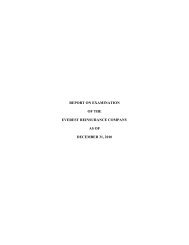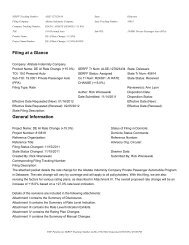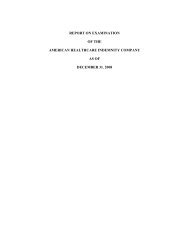SURPLUS LINES FAQ - Delaware Insurance Commissioner
SURPLUS LINES FAQ - Delaware Insurance Commissioner
SURPLUS LINES FAQ - Delaware Insurance Commissioner
Create successful ePaper yourself
Turn your PDF publications into a flip-book with our unique Google optimized e-Paper software.
36. In Part 2 of the annual tax return we provide information about the State Support of Fire Companies,<br />
but the form says this is not a tax. Can you please tell me why we provide this information to you?<br />
This section of the form is used to report what is generally referred to as “Fire Tax” because the<br />
premium amounts stated on these reports are used to calculate the amount of State support for<br />
volunteer fire departments. Fire Tax is not actually a “tax”, but rather a “break-down by lines<br />
and location” report.<br />
On the premium tax report, a company must report ALL insurance business written in <strong>Delaware</strong><br />
by the broker during the previous calendar year. But the Fire Tax Report assembles separate<br />
data only on property/casualty lines of business and breaks down the premiums based on the<br />
location of risks: City of Wilmington, New Castle County, Kent County, and Sussex County,<br />
respectively.<br />
Based on the reported Fire Tax figures, a specified percentage of the funds collected through<br />
premium taxes is then disbursed to volunteer fire departments throughout the State, and to the<br />
City of Wilmington in accordance with 18 Del. C., §705(b).<br />
IMPORTANT: The information requested in Part 2 of the annual tax report is required by law.<br />
If Part 2 of the form is not completed, the tax return will be considered incomplete will not be<br />
accepted. The tax report will be returned to the broker for completion and the broker will be<br />
subject to the Late or Incomplete Filing Penalty.<br />
37. If we have a credit due in one quarter on return premiums, should we carry it over to the next<br />
quarter? For example, in the 2nd quarter we had a credit due to us, but in the 3rd quarter we owe tax.<br />
Should we apply the credit to the 3rd quarter amount and pay the difference, or should we pay the entire<br />
3rd quarter amount and wait for the refund to come later?<br />
You may apply the credit to the third quarter amount and pay the difference, but you must make<br />
a note of it on the third quarter SL-1917 form showing that it is a credit from the second quarter.<br />
Please note that you may not carry a credit from year to year. When you file the annual SL-<br />
1916 form you will report all the premiums written during the year, as well as all the return<br />
premiums, and if there is a credit at year-end the Department will issue a refund check.<br />
38. We are normally a wholesaler and receive our business through a retail broker. We now have a case<br />
in which we are the Retailer and the SL Broker. What forms are required and what do we have to file<br />
with the Department when we place this business?<br />
First, you need to complete the SL-1904 listing the declinations that show that a diligent effort<br />
was made to place the risk in the admitted market. This form gets placed in your files. Do not<br />
send it to the Department.<br />
After the coverage is placed, submit the SL-1905 Notice of <strong>Insurance</strong> Transaction Form as an<br />
email attachment in Excel format. This form must be submitted within 30 days after the policy<br />
effective date. Do not send the SL-1905 in paper or PDF format and do not attach anything to it.<br />
You will pay the tax on the policy when you submit the next quarterly SL-1917.






